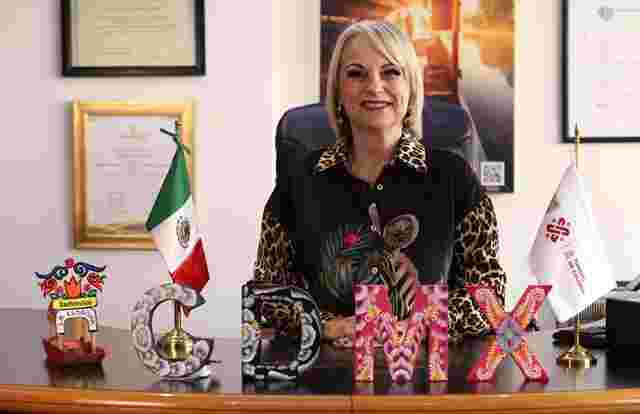HOMBRE Exclusive: CDMX Secretary of Tourism Nathalie Desplas On The Future Of ‘The City That Has It All’
14 Jun 2024 by Francisco Romeo in Business, Celebrities, Cuisine, Escape, Europe, Event, Fame, Film, Films, General, Home, Hotels, Latin America, Money, Music, Pleasure, Power, Profile, Restaurants, Spirits, Sports, Technology, Television, Theater, USA, Woman

Mexico City remains one of the greatest capitals of the world. As CDMX‘s motto goes, this is truly “The City That Has It ALL.” We had an opportunity to discover the best the city has to offer and we’ll be bringing you an in-depth travel guide so you can start planning your next visit. We begin with a conversation with Nathalie Desplas, Secretary of Tourism of CDMX.
In an exclusive interview she details the continuos and rapid growth that is driving the city forward.
Nathalie Desplas has been Secretary of Tourism for CDMX since July 2022. With over 25 years of experience in the tourism sector, a degree in Economic Sciences, and as a former professor in Economics and Tourism she is leading a team transforming the city’s narrative for residents and tourists alike, highlighting the movement that now makes CDMX greener, safer, with a transportation system that is the envy of most major cities.
As the capital of Mexico CDMX is the most populous city in North America. It’s composed of 16 boroughs, since 2016, known as alcaldias. The population of Greater Mexico City is about 21.3 million, which makes it the largest metropolitan area of the Western Hemisphere, and the largest Spanish-speaking city in the world.
Mexico City is also both the oldest capital city in the Americas and one of only two founded by indigenous peoples. Originally built on an island in Lake Texcoco by the Aztecs in 1325 as Tenochtitlan, it became officially known as Ciudad de México (Mexico City) in 1586. It has been the political, administrative, and financial center of a major part of the Spanish-speaking world since then. After independence from Spain, it became the Federal District in 1824 and remained so until 2016 when it was rebranded CDMX to reflect the growth and importance of its rural regions.
As a cultural destination it is unrivaled in the Americas. It has more museums than any city on Earth, save London. Its population thrives on a rich inherent culture combined with the many influences that have touched it from abroad.
HOMBRE: What are some of the new developments happening in CDMX?
CDMX Secretary of Tourism Nathalie Desplas: We want to transmit the new narratives of CDMX. Usually you think of it as a corporate city, a place for business. And yes, it is still that, but there are new narratives that are worth getting to know.
There are certain city icons that are well positioned and you already think of visiting, but we are working to give visibility to other places that have always been there and are divine. We want the public to also visit and enjoy new regions within the City.
H: What should people know about CDMX?
ND: Most people are not aware that fifty-nine percent of the city is rural. When you think of Mexico City, one of the greatest metropolis and ranked in the top five of the biggest cities in the world, you imagine skyscrapers. And that’s true in a part of the city, but we are also working in the rural parts.
 We call it ‘suelo de conservación‘ because it’s been restored and renovated. They were difficult places before and now we have created ‘urban forests.’ Today thirty percent of the city is an ‘urban forest,’ which is a lot.
We call it ‘suelo de conservación‘ because it’s been restored and renovated. They were difficult places before and now we have created ‘urban forests.’ Today thirty percent of the city is an ‘urban forest,’ which is a lot.
 In the past few years we planted over fifty million trees and plants. That means the city is always greener and cleaner. Many different species of birds have returned. We have 128 days a year without contamination which is a major green work.
In the past few years we planted over fifty million trees and plants. That means the city is always greener and cleaner. Many different species of birds have returned. We have 128 days a year without contamination which is a major green work.
The city has received awards for fighting climate change.
H: We understand CDMX is very welcoming to LGBTQ+ communities, tell us about that.
ND: In terms of LGBTQ+ we are one of the most advanced capitals in the Americas. LGBTQ+ is very important to us because we are a city of innovation and rights. We have awards as the best urban destination. That is one of our sub-genres but we have many others.
H: What are some other types of tourism you develop and attract?
ND: We really have it all. We have cultural tourism, historical tourism, convention and conferences. And when we speak of rights we mean the right for all to be respected on their trip in the best way possible.
We have medical tourism. The doctors here are recognized and have international accreditations. But they also have that warm treatment with people that is so welcomed when they travel.
 We have religious tourism. We have the Basilica de Guadalupe which is the second most visited place after the Vatican. We receive twenty million people a year. The Day of the Virgin is December 12 and they visit from all around the country, they make pilgrimages which is something special.
We have religious tourism. We have the Basilica de Guadalupe which is the second most visited place after the Vatican. We receive twenty million people a year. The Day of the Virgin is December 12 and they visit from all around the country, they make pilgrimages which is something special.
 There’s nature tourism, sports tourism, we have massive events like Formula 1. We have concerts in el Zócalo where we had a record of 300,000 people attending. The Zócalo plaza is one of the largest in the Americas.
There’s nature tourism, sports tourism, we have massive events like Formula 1. We have concerts in el Zócalo where we had a record of 300,000 people attending. The Zócalo plaza is one of the largest in the Americas.
H: What about gastronomy?
ND: I was saving that for last.
It used to be that gastronomy was a secondary motivation. We need to eat when we travel.
Not anymore. Nowadays we see CDMX as the world’s Cathedral of Gastronomy. The Cathedral has a spiritual feeling and we want to say that gastronomy is a unique experience. CDMX is the most diverse city when it comes to pre–hispanic dishes.
 Besides pre–hispanic food there’s the traditional dining from rural sections in the city. There’s also contemporary, fusion, ‘cocina de autor,’ and all the stands we have in the streets. Here we have over 57,000 dining spots. That’s very important.
Besides pre–hispanic food there’s the traditional dining from rural sections in the city. There’s also contemporary, fusion, ‘cocina de autor,’ and all the stands we have in the streets. Here we have over 57,000 dining spots. That’s very important.
This year the Michelin Guide came to CDMX and gave Pujol and Quintonil two stars each. Quintonil has been named as t
The Best Female Chef in the World is here, an honor received by Elena Reygadas of Rosetta. (The World’s 50 Best – 2023.)
 There’s ‘fine dining’ in the streets, but it’s more traditional food.
There’s ‘fine dining’ in the streets, but it’s more traditional food.
Tacos al pastor is considered one of the most traditional dishes of CDMX.
 H: How easy is it to get around CDMX?
H: How easy is it to get around CDMX?
ND: We have one of the most effective mobility systems in the world.
And that is achieved thanks to a card of integrated mobility.
Originally it was planned for locals and residents but it also helps visitors because it’s a very practical way to move around the city.
It’s like a debit card and with it you can have access to all different systems of mobility. You can take the bus, the cable car, ride bicycles, the metro, everything.
That card is unique in the world. It recently received an award in Paris. It facilitates everything, making it really easy to move around.
 H: Is it convenient to bike around the city?
H: Is it convenient to bike around the city?
ND: We have over 480 eco bike stations. They have been very successful with foreign tourists who use them on a regular basis. On Sundays one of the most beautiful streets, Paseo de la Reforma, among many other avenues, is closed to vehicular traffic. We encourage people to use their own bikes, or use the ones available for rent. We even have tour operators that have created tours using ecobicis.
H: What else are you doing to improve the environment?
ND: It’s important to discuss climate control. There are many more electric buses now.
It’s ecologically friendly and we’re going for more everyday.
 We have a cable car where you have amazing views. You can enjoy one of the most important urban galleries in the Americas when you see the murals in Iztapalapa. More than 9,000 murals that have been counted between the rooftops and the walls of the homes. There are some you can only see from the cable car.
We have a cable car where you have amazing views. You can enjoy one of the most important urban galleries in the Americas when you see the murals in Iztapalapa. More than 9,000 murals that have been counted between the rooftops and the walls of the homes. There are some you can only see from the cable car.
As a matter of fact, we’re hosting games in the next World Cup and FIFA filmed one of their videos here. They selected the rooftop from a school so you’ll soon be able to see it.
This is more than a system of transportation and ecology, it also allows us to witness pillars of culture in the city. There are two cable car lines and we’re going for the third, and according to the Guinness Book of World Records we have the longest one in the world.




















